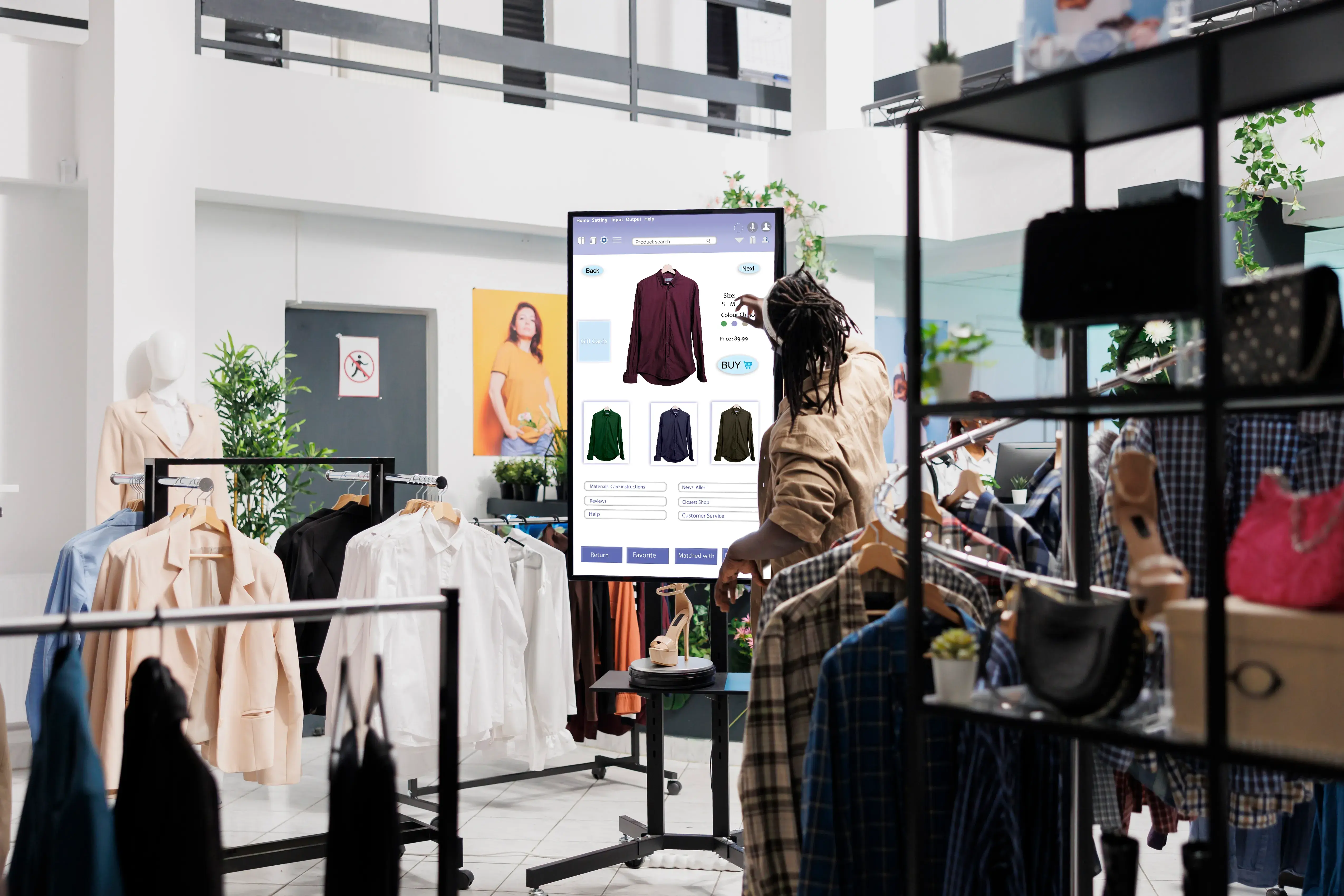Recently, discussions about omnichannel retail have surged, focusing on hyper-personalization, AI evolution, eCommerce growth, and digitally native brands entering the offline space.
We’re experiencing a retail market with increasingly digital-savvy consumers who demand individualized online shopping experiences, convenience, and a unified customer journey - from browsing to buying or delivery to returns.
On top of these imperatives, the abundance of channels available to consumers (digital & physical) raises the stakes for a flawless omnichannel approach, where even the smallest hiccup in the retail experience can prompt customers to switch to competitors.
As a result, top decision-makers prioritize omnichannel retail strategies to provide customers with better experiences across all touchpoints.
Our previous article explored improving the online shopping experience with top UX/UI design practices. Now, it’s time to focus on the omnichannel retail experience and its overall impact on customer experience.
Key Highlights
- Omnichannel retail is an approach to delivering a positive brand experience across all channels, providing customers with a unified shopping experience.
- A retail omnichannel strategy means integrating customer touchpoints such as brick-and-mortat stores, online shopping platforms, and mobile apps.
- Social media is essential in omnichannel retail. Brands can engage with customers on social channels and drive sales through targeted campaigns.
- Mobile devices are essential in the omnichannel retail strategy. They allow customers to shop on the go and access personalized promotions.
- Online shopping has become a pillar of any omnichannel retail strategy. A positive online shopping experience is as important as the in-store shopping experience.
- Data analytics provides insights into customer preferences and behaviors, allowing retailers to create personalized shopping experiences.
|
Omnichannel Retail: What Is a 360-Degree Customer Experience
Omnichannel retail combines online and offline sales channels to offer customers a unified shopping experience. It ensures consistency and convenience across multiple channels like websites, mobile apps, a brick-and-mortar store, and customer service points.
A top-tier retail omnichannel experience drives sales, boosts customer loyalty, and helps retail businesses differentiate themselves from the competition while better meeting evolving consumer expectations and market demands.

What is the omnichannel trend in retail?
The omnichannel trend in retail revolves around brands adjusting to changes in consumer behavior and embracing digital technologies. Nowadays, customers interact with brands through multiple channels before making purchases. They expect a simple and personalized shopping experience across all online and physical outlets, from browsing to ordering and receiving their purchase. If their brand of choice can’t deliver this experience, it could prompt customers to explore other options.
Why Should You Care About an Omnichannel Retail Strategy
The rise of omnichannel retail has changed how consumers shop, offering them more options and flexibility. Now, customers expect seamless and personalized experiences. They can browse, compare, read reviews, and purchase online, in-store, or via delivery.
Brands that adapt to omnichannel and prioritize customer satisfaction are more likely to retain customers and drive repeat business, thus fostering customer loyalty.
According to a Capital One Shopping study, 73% of retail customers are omnichannel users. Additionally, retailers offering omnichannel experiences retain 91% more consumers than those using only one channel.
The Future of Omnichannel Retail — Is It the Next Big Thing?
An omnichannel approach is how modern retailers build strong and lasting relationships with their target audience and boost their competitiveness. But what is a complete sync between online and offline channels, exactly? And how does one achieve that? That’s precisely what we’re exploring below.
Understanding the Omnichannel Approach

The omnichannel approach in retail refers to integrating different shopping channels to provide customers with a holistic shopping experience. Although it sounds simple, this approach goes beyond just having a presence on multiple channels.
To build a top-notch omnichannel retail experience, you must ensure that all channels blend in a way that provides positive CX at all touchpoints, all the time. How exactly?
Starting with a customer-centric business model, you should first understand the customer journey and identify the different touchpoints where they interact with your brand.
The customer journey in eCommerce is complex and often non-linear, meaning customers don’t necessarily navigate through your sales funnel from top to bottom. Customers may research online shopping avenues, visit stores for hands-on experiences, and then make online or in-store purchases.

Hence, our next step is diving deep into understanding the customer journey and identifying touchpoints where omnichannel retail interactions occur. The entire experience must provide a positive brand experience, regardless of touchpoint, channel, or stage of interaction.
The Retailer’s Perspective: An Omnichannel Retail Experience Use Case
Consider a retail business selling electronic and home improvement appliances online and in-store, specifically hair stylers for women:
- While their focus has long been on the physical location, they now see a surge in social media inquiries through direct messaging and significant added traffic on their website.
- Through customer journey mapping via UX/UI tools such as session recordings or HTTP cookie analysis, they notice that people research products online multiple times but don’t complete the purchase. Instead, they visit stores for hands-on experiences and live testing and then purchase online. Some buy in-store after reviewing products online (a growing trend known as showrooming).
- Another retailer finding is that while many users educate themselves about the brand on the website, only a few convert over time. They spot an inconsistency in their omnichannel retail experience.
- The retailer finds that its website isn’t fully optimized for search engines and that the UX/UI aspect lags behind the competition.
The challenges identified are:
- The online and physical channels aren’t well integrated, as consumers are not up to date with the current availability of their favorite products, leading to lost opportunities in the consideration stage.
- Another problem is that the company isn’t maximizing its online exposure, which, given the journey mapping data, could also increase its on-site traffic.
The retailer implements several omnichannel initiatives:
- Real-time inventory tracking to update product availability across all channels, allowing customers to make informed decisions whether they are shopping online or in-store.
- A protocol for notifying customers about low-stock items or exclusive in-store products during their in-store visits and via online platforms to drive decision-making.
- A new UX/UI feature capitalizing on their customer journey encourages website visitors to try their favorite products for free at their nearest store.
- A unified customer profiles dashboard tracks customer purchases online and offline, offering personalized recommendations and rewards based on their shopping history.
- Consistent branding across online and offline channels to build a cohesive brand identity. A redesigned website reinforces the retailer's image through branded and responsive design online, while branded signage, displays, and promotional materials experiences offline.
- An integrated checkout process syncs across devices and locations, ensuring a smooth and secure experience using responsive design. This process offers a unified shopping cart that allows customers to add items from online and physical stores and check out from any channel.
|
The Importance of UX/UI in an Omnichannel Retail Business
UX/UI focuses on creating a visually appealing and user-friendly interface that guides customers through the purchase journey. That matters more than you think, as nearly 94% of the initial perceptions formed about a website come directly from its design. Moreover, an outstanding 80% of consumers are ready to spend extra for an improved user experience.
With great UX/UI, you’re doing just that – simplifying the online shopping experience for website visitors, which directly influences the omnichannel retail experience, engagement, and, ultimately, conversion rates.
In an eCommerce landscape where conversion rates are consistently dropping, even though revenue per visit is a growing metric, the picture is clear: financially potent users are willing to spend money online. Still, retail platforms aren’t turning them into paying customers.
The greatest problem of all? Retail global eCommerce sales are projected to experience a 39% growth in the coming years. Retailers can no longer postpone this aspect of their business, and investing in UX/UI as part of their omnichannel strategies is a present imperative.
5 UX/UI Strategies to Take Your Omnichannel Retail eCommerce to New Heights
One of the many reasons UX/UI is considered a missing piece in many omnichannel retail strategies is customer dissatisfaction with poor interfaces, which often show up as cumbersome navigation, slow loading times, and frustrating checkout processes.
So, let’s delve into five expert-vetted strategies to overcome omnichannel barriers as you step into the future of retail.
1. Start with consistent branding

This goes beyond visual identity. Unified branding encompasses tone, style, and communication, ensuring a holistic experience across all platforms — from your eCommerce website and mobile app to physical stores and in-store customer service desks. Implementing a consistent branding strategy involves:
- Visual Consistency – use the same color schemes, logos, and typography across all channels. Customers who encounter the same design, messaging, and experience across all channels are more likely to trust and engage with a brand, and implicitly, deliver higher retention and conversion rates.
- Tone and Messaging – maintain a consistent voice in customer communications, advertisements, and content. Whether customers read a product description, a promotional email, or an in-store ad, the tone, language, and values should reflect a cohesive brand personality. One great example of this is Nike, a company that always reinforces its values through consistent messaging, and has become a worldwide phenomenon in athleticism, excellence, and sports.
- Style Alignment – this refers to all of it, or maintaining a consistent tone of voice, language style, and brand persona across all platforms. Retailers can achieve this by developing brand communication guidelines that define specific rules for tone, language, and phrasing in various scenarios. Technology can also play a role in maintaining alignment. AI-powered sentiment analysis can help brands assess whether messaging aligns with their intended tone across digital platforms. Customer relationship management (CRM) software can ensure that personalization efforts match the brand’s style in outreach and promotions.

Consistent branding means that whether a customer shops online, on mobile, or in a physical store, they perceive the same brand ethos.
From a UX/UI perspective, this aspect is crucial, as it directly affects how users interact with and perceive your platform. Here are some key aspects to consider:
- Make sure that all interface elements, such as buttons, menus, and dialog boxes, are consistent in appearance and behavior across platforms.
- Adopt a responsive design with interfaces that adapt to various screen sizes.
- Make sure that your digital platforms are accessible to all users, including those with disabilities. Use color schemes that are visually accessible, provide text alternatives for images, and implement keyboard-friendly navigation.
- Microinteractions, such as button clicks, form validations, or hover effects, should be designed to reflect your brand’s style and tone.
2. Seamless transitions between online and offline channels

For a frictionless omnichannel retail experience, consider implementing clear, intuitive interfaces that allow customers to access:
- In-store availability checks on check product availability at nearby stores and online.
- Online reservations for in-store pickup and BOPIS (buy online pickup in-store) actions.
- Easy returns that simplify the process of returning online purchases at physical locations. Include clear options for selecting pickup locations and times, and provide visual confirmations.
- Loyalty app purchases, loyalty points, and rewards in real time, with suggestions on redeeming them. If you're not actively investing in your loyalty app, or you're postponing a much-needed app modernization, consider this:
| Ivatherm transformed customer engagement with Ivaclub, a loyalty program developed by ZItec, which seamlessly integrated into the brand’s digital ecosystem. The loyalty app rewards users with 10% cashback in points, exclusive event bonuses, and engagement-based perks. In just four months, 4,000+ users joined, driving 46% of registered user revenue and boosting Lifetime Value by 58%. |
All in all, great omnichannel strategies are about finding small yet impactful ways to delight customers. For example, you could use QR codes in physical stores to provide additional product information or online reviews to improve the in-store shopping experience with online elements.
3. Prioritize the mobile experience

It's a no-brainer that any business should prioritize the mobile experience, yet many websites are still not fully adapted to mobiles. That’s because a comprehensive mobile strategy involves more than making the site look good on smaller screens. It includes:
- Fast loading times Compress images, leverage caching, and optimize code to reduce lag.
- Responsive design – Make sure layouts dynamically adjust for usability across different devices and resolutions.
- Mobile-first navigation – Menus, CTAs, and key interactions should be designed for mobile users first, with intuitive gestures like swiping and easy-to-reach buttons.
- Accelerated Mobile Pages (AMP) – Used to strip unnecessary elements, ideal for content-heavy sites and publishers.
- Touch optimization – Make sure buttons are thumb-friendly (44x44px minimum), forms are easy to fill, and interactive elements respond smoothly to gestures. opt for thumb-friendly designs
Struggling to meet customers where they are, whether online, in-store, or via apps? Not sure what a successful omnichannel retail strategy can look like for your organization?

4. Integrate AI data analytics into your omnichannel strategy as part of UX/UI design

AI in data analytics allows you to leverage vast amounts of data from diverse sources—online interactions, in-store behaviors, mobile app usage, and more — to gain comprehensive insights into customer preferences and behaviors.
Today, many data analytics tools, such as Google’s Customer Data Platform, allow retailers to create detailed customer profiles that help improve UX/UI efforts, personalize interactions, boost loyalty, and increase customer lifetime value through informed decisions.
Here’s how data analytics and AI can be used to improve UX/UI and enhance your customer’s journey:
- In retail, AI can analyze user data such as past purchases, browsing history, and preferences to tailor the user interface to individual needs. For instance, AI can dynamically alter the layout of a mobile app or website to highlight products or features that are most likely to interest the user.
- AI applications include using this technology to improve search functionalities on platforms. Models like Predictive or Gen AI can anticipate what a user is looking for as they type, offering autocomplete suggestions based on popular items, recent trends, and the user’s past behavior.
- First-party data combined with the right technology can help understand how users navigate through your app or website and identify any common drop-off points. This information can be used to improve navigation paths and remove friction from the buyer journey.
- With data at your disposal, you can analyze market conditions, customer demand, and competitor pricing to adjust prices dynamically and maximize profits in real-time.
- Use AI to manage and analyze A/B testing on different UI elements. AI can quickly determine which version performs better and apply these insights to optimize the design and functionality of your platforms.
5. Personalize the shopping experience

Hyper-personalization is a hot topic among retailers, who are beginning to invest heavily in this approach as part of their omnichannel strategy. Personalization makes consumers feel more valued and likely to spend more while becoming recurring customers. Since 70% of decisions are based on emotional factors, fostering a connection with your audience is THE winning approach for any retail business.
Here’s what you should consider as part of your personalization efforts:
Unified customer profiles
Integrating data from all touchpoints creates detailed customer profiles. This includes purchase history, preferences, online browsing behaviors, and social media interactions. Tools like CRM systems and Customer Data Platforms (CDPs) can help consolidate this data to provide a 360-degree view of each customer.
Segmentation and targeting
Use the data gathered to segment customers into distinct groups based on their behaviors, preferences, and demographics. This segmentation allows for more targeted marketing efforts, such as personalized emails, tailored promotions on-site, and customized product recommendations as they browse. For instance, customers who frequently purchase children's products might receive promotions for back-to-school campaigns.
Contextual and behavioral personalization
Beyond static data, consider the context of each interaction. For example, if a customer often shops late at night, tailor your messaging to reflect late-night browsing habits with appropriate product suggestions or special night-time offers. Similarly, content and recommendations should be adjusted based on the customer's location, weather conditions, or local events.
Do you need help implementing dynamic hyper-personalization in your retail organization?

Dynamic content and real-time interactions
Retailers using tools like Google’s RecommendationsAI (designed to help retailers deliver highly personalized product recommendations at scale using ML) prioritize customer experiences and personalize user experiences based on data insights. Dynamic content that changes based on the user’s past interactions and real-time website behavior works well for retailers.
This could include changing the homepage layout, featured products, and special offers to better align with the individual's interests. Real-time analytics can help adjust these elements dynamically to cater to the customer’s immediate needs and actions.
The Nearshoring Partner that Drives Real Results in the Omnichannel Retail Market

Is your retail organization just keeping up with digital transformation or setting the pace?
In omnichannel retail, staying on top of the game means your tech needs to be as dynamic and user-friendly as your customers expect. Whether you’re struggling to:
- Reimagine mobile apps
- Improve omnichannel experiences between physical outlets and digital platforms
- Upgrade your eCommerce platforms through a fool-proof infrastructure that integrates with all your systems and digital assets
Consistency in user experience is key.
As we conclude, remember that while UX/UI design lays a strong foundation for improving your digital presence within an omnichannel strategy, a solid tech infrastructure is equally important.
At Zitec, we help you improve operations with scalable solutions that boost user experience and position your organization as a retail leader in the market. Using our 20 years of experience delivering over 750+ software projects, we deliver bespoke solutions that enhance your platform’s UX/UI for top-tier customer experiences.
Ready to upgrade your omnichannel retailing strategy? Forget off-the-shelf solutions. Get yourself a trusted retail partner. Our ready-to-operate enterprise-level teams will deliver the fastest, most competitive UX/UI retail solutions while keeping your data safe and your customers returning for more.






.webp)